For the first post of this new year were open the ball with the oddballs of the Royal Navy. Ships that were out of the ordinary and in the 19th Century pioneered some untapped aspects of naval technology, while having no real succession. They were just pretty unique. Among these are the famous turret ship HMS captain, the coast defence monitor HMS Abyssinia, the breastowrk Monitor HMS Glatton, the ironclad ram HMS Hotspur (seen here), The torpedo vessel HMS Vesuvius, and the torpedo ram Polyphemus. HMS Hotsput was a unique sea going torpedo ram, a type mostly fieded by France which prioritize ramming tactics above all else with a heavy gun in gunhouse to soften its target. An unusual ship which was completed in 1871, then modernized and reclassified in 1883, as an ironclad torpedo ram, sold for BU in 1904. See also: The RN in 1870
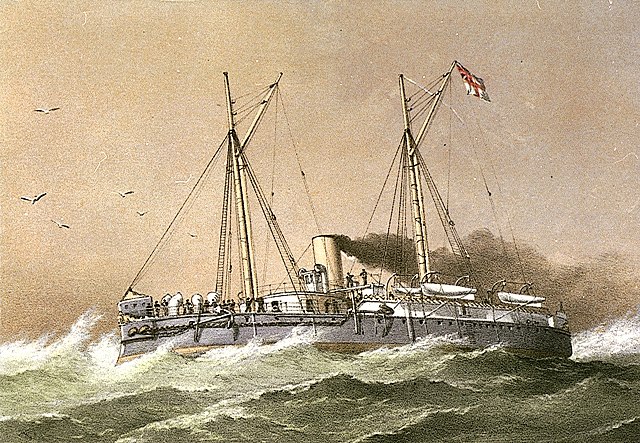
Development
Ramming had been a steady tactic for centuries at the age of rowing galleys, and remain a thing even at the blackpowder age, as far as Lepanto. However the combination og heavy artilly in gunports and constantly improved rigging led to the classic battleline tactics that were still a thing in 1850. Ramming disappeared as sail-powered warships had intrinsic limitations of speed and manoeuvrability. But the concept remained alive and resurfaced with the advent of steam-powered vessels. The ram made a comeback as a potent weapon in Naval circles, in Europe with the first ironclads, and in the American Civil War, when many attempts were made, like Virginia sinking the Federal Cumberland and of course on the other side of the world in the Adriatic, the battle of Lissa which all but at the contrary exaggerated faith in rams as credible, even decisive weapons in 1866. All ironclad battleships for the next 40 years systematically had a ram. In Britain, the Revenge class were last built to include such a weapon.
Now, Britain oberved France after the disastrous 1870 war trying to reconstitute a navy with a far lower budget. Before the Jeune Ecole took hold, experimentations with new coastal defence vessels led to a serie of Marine nationale’s ironclad rams. Britain, not to be undone in this class, also launched a program to test the vessel. HMS Hotspur (named after 100 years war knight Henry Percy (“Hot spur”)) was designed to match similar generation ironclad rams such as the Taureau (“bull”). The ship was designed entirely in a single purpose in mind, ramming an opponent. It did not started from scratch and the yard chosen, Napier in Gova,, retook the design of the breastwork monitor Glatton and recorked the hull and especially superstructures to create a very unique vessel, one called for a long service life in the RN, albeit which did not led to any succession.
Design of the class
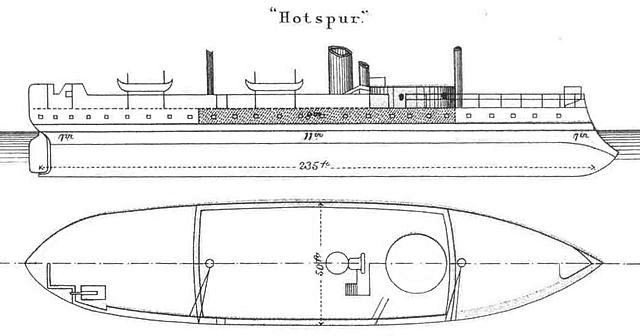
HMS Hotspur was designed to take part in a battle Fleet, and disrupt the enemy battle line by charging at it. The hope was that by depriving the enemy it’s fullbroadside, as ships would be trying to didge the ramming attack, would lost their firing angle. Of course it was also hope to ram and sink a valuable ironclad in the process. Thus, unlike the Glatton’s hull, Hotspur’s projected ten feet (3 m) ahead of her bow, reinforced by an extension of the armoured belt. The entire forward section was also very well protected and the ship was almost imperveous to heavy fire forward.
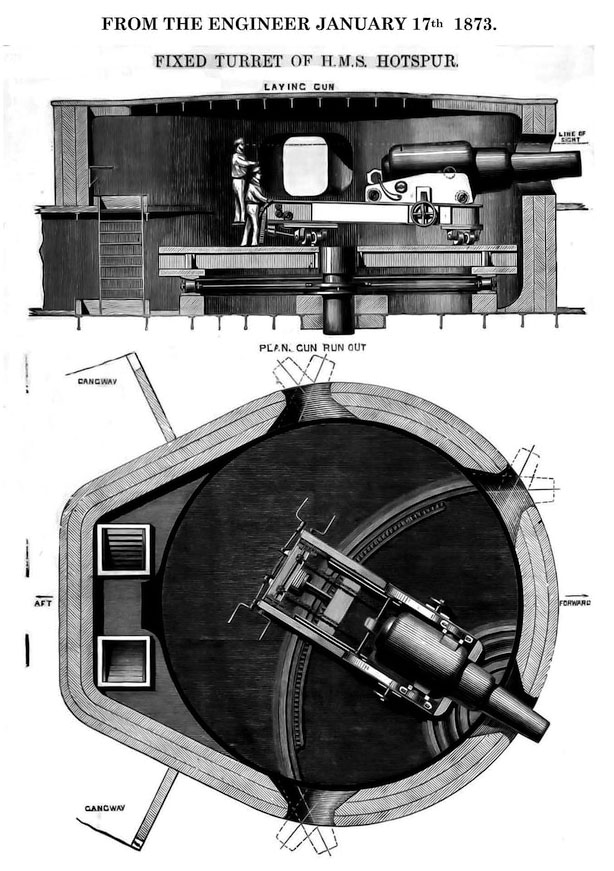
Hull and general design
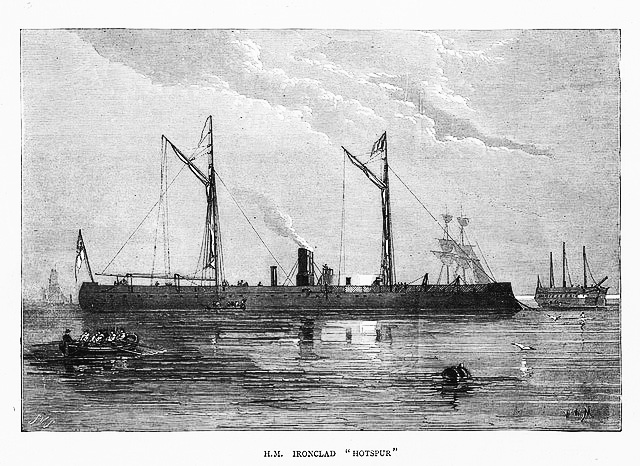
Hotspur was an ironclad ram constructed to match French vessels of similar type. The general layout was similar to Glatton but the freeboard was increased to the height of the breastwork by the addition of an unarmoured hull structure above the belt. In place of the turret she carried a fixed, armoured gun house with four gun ports, it being considered that the turret would not stand up to the shock of ramming. She displaced 4,331 tons and her hull ratio (lenght to beam) was more for agility than speed (meaning beamier rather than narrower). This she was 235 ft (72 m) long overall, for a beam of 50 ft (15 m) and a draught varying between 19 ft (5.8 m) light and 20 ft 8 in (6.30 m) deep load.
Design-wise, she had a crescent curved, pointy ram forward, a bulwarked forward prow, flush deck, bulwarked amidship to stern section. The fixed gunhouse was rounded lik a turret but had several apertures for the main gun, it’s roof could be used as additional bridge, but the CT was at its rear, in from the the small wheelhouse bridge cabin. There was a small strcuture to access the engine room amidship with a single funnel, and the rear was plain flat deck cut by the aft mast, aft gun positions and access hatches to lower levels. The hull was divided into three decks. She carried 209 officers and men and had four service boats under davits aft. The hull had counter-keels.
Powerplant
Hotspur had two shafts with 2-bladed propellers each, single, large vertical rudder. She was powered by Napier reciprocating steam engine, which developed 3,500 indicated horsepower for a top speed of 12.65 knots (23.43 km/h; 14.56 mph) which was not brillant. She was however a good gun platform, very steady and manoeuvrable, but was unable to make headway in heavy seas. This made her virtually useless in her intended role because of her lack of fire power on forward bearings and lack of speed and seakeeping qualities, so she was relegated eventually to the role of coast defence ship after perhaps eight years in her intended role.
Protection
-Hotspur’s belt was ll-inches (280 mm) amidships and tapering to 8-inches (200 mm) at the ends.
-The armoured deck was 2-3/4-inches thick. 2.75 inches (70 mm) tapering to 1 inch (25 mm).
-The breastwork was an uniform 8 inches (200 mm).
-The gun house had 10-inches (250 mm) walls with an 8-1/2-inches (205 mm) back, and four apertures.
-The conning tower was mounted on the rear roof of the gun house, 10 inches (250 mm) front, 6 inches (150 mm) rear.
Armament
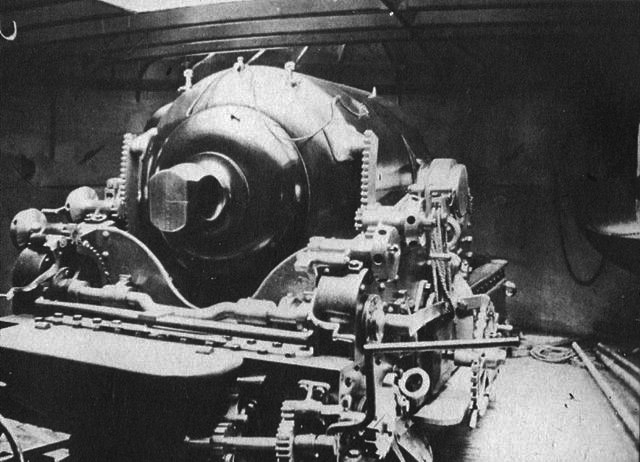
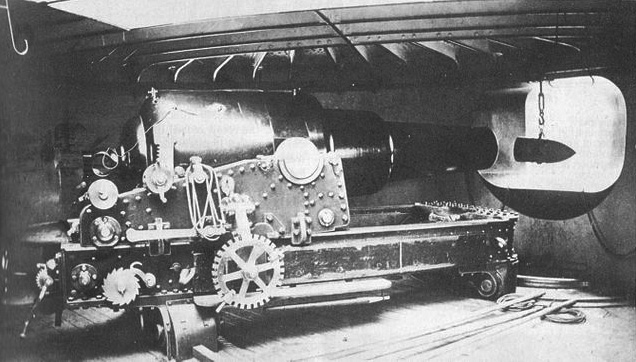
The 12-in MLR was mounted on both traversing arcs and a turntable, allowing for positioning and training at each port. The two 64pdr guns were mounted aft behind bulwarks and were unprotected. The principal weapon was the ram, projecting 10ft from the bow and supported by a downward extension of the side armour.
Original Armament
As an armoured ram HMS Hotspur was armed with a single 12 inch (305 mm) 25-ton muzzle-loading rifle. This was basically a “one trick pony”, designed to fire once before the actual ramming as reload was an operation lasting for two minutes, providing the gun was not moved from one to another porthole.
This classic RML 12-inch weighted 23 to 25-ton, 600 to 608.4 pounds (272.2 to 276.0 kg) as Palliser, firing a 497 pounds (225.4 kg) Common & Shrapnel shell of exact caliber 304.8 mm at a muzzle velocity of 1,300 feet per second (400 m/s).
This was completed by two 64-pounder muzzle-loading rifles, emerging from ports at the stern, and masked.
These BL (Breach Loaders) 6-inch (152.4 mm) Mk II guns furing 100 pounds (45.36 kg) shells from a 3 motion interrupted screw using De Bange obturation at 1,960 feet per second (597 m/s) at max 10,000 yards (9,100 m).
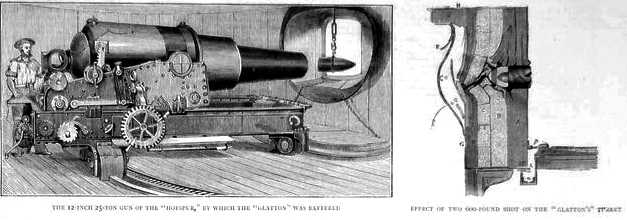
Post-refit 1883 Armament
HMS Hotspur was reconstructed at Lairds in 1881-83. The gun house was replaced by a compound armour turret, 23-in steel on 54-in iron, containing two 12-in MLR guns, and the 64-pdrs were replaced by two 6-in BLs. The breastwork was removed and replaced by a full-width box citadel with 8-in sides and bulkheads. The superstructure was remodelled, and the ship was re-boilered, had steam steering gear added, was fitted with torpedo Jaunching gear and had a torpedo boat added to her boat complement.
As completed so she had two new 12 inch (305 mm) muzzle-loading rifles, two BL 6-inch (152.4 mm) Mk II guns, eight 3 in (76 mm) quick-firers and eight machine guns for close quarters.
⚙ specifications |
|
| Displacement | 4,331 tons |
| Dimensions | 235 x 50 x 19 ft/20 ft 8 in DL (72 x 15 x 5.8-6.30 m) |
| Propulsion | 2-shaft Napier reciprocating, 3,500 ihp |
| Speed | 12.65 knots (23.43 km/h; 14.56 mph) |
| Range | |
| Armament | 1× 12 in (305 mm) MLR, 2 × 64-pdr MLRs |
| Protection | Belt 11 in, Breastwork 8 in, Turret 10 in, CT 10 in, deck 2.75 in |
| Crew | 209 officers and men |
Career of HMS Hotspur
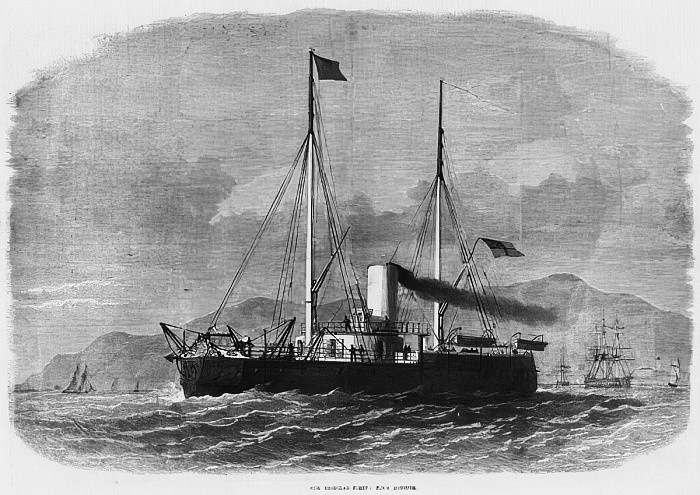
HMS Hotspur was commissioned at Devonport in 1871 and on 26 January, she collided with the steamship Lady Woodhouse, off Plymouth. Both were severely damaged. Hotspur was repaired at Plymouth. On 12 January 1871 she carried out her heeling trials in Keyham Basin. She live-fired her 12-inch on Glatton in a test in 1873. The latter resisted well her hit. She remained in reserve until 1876.
She was assigned to serve with HMS Rupert and bith proceeded to the Sea of Marmara as the the Russo-Turkish war raged on in 1878. She returned to Devonport and remained inatcive until a full reconstruction at Laird & Sons Co. from 1881 to 1883 after a refit already in 1897.
On 11 January 1882, the body of Petty Officer May which srved on board was discovered close to one of the piers of Camel’s Head Bridge (Saltash) and foul play suspected by the Police but it was never solved.
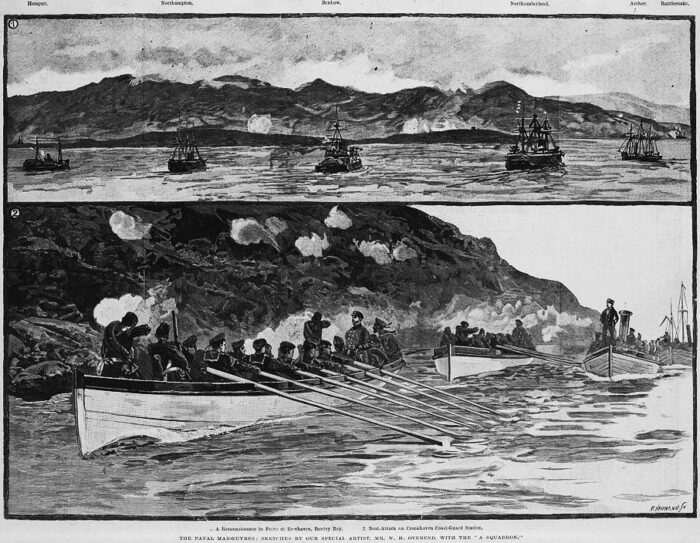
The Naval Manoeuvres at County Cork, Ireland, 1888
Her only activity after this was with the “Particular Service Squadron” from 1885 and by April 1886 she wa smoved to Holyhead. She became a guardship at Holyhead until 1893. On 19 Juned 1886 she was still in the Channel Squadron with HM Ships Hercules, Northampton, Devastation, Penelope, Hotspur, Ajax, Shannon and Belleisle and sailed a last time to Bantry Bay. On 21 May 1887 she was recommissioned at Portsmouth with a crew from “Penelope”.
in 1890 she was versed into the First Reserve. She becale a coast Guard and Drill Ship within the Naval Reserve in Harwich and a the tender “Firefly”, “Seamew”. She also tended to the Coast Guard Cruisers “Adder”, “Beatrice”, “Mermaid”, in reserve until 1897, posted as guardship at the Royal Naval Dockyard a the Imperial fortress colony of Bermuda until sold for BU, after beign recommissioned a last time on 11 March 1900, reported in her last North America and West Indies Station.
Failure as a Concept
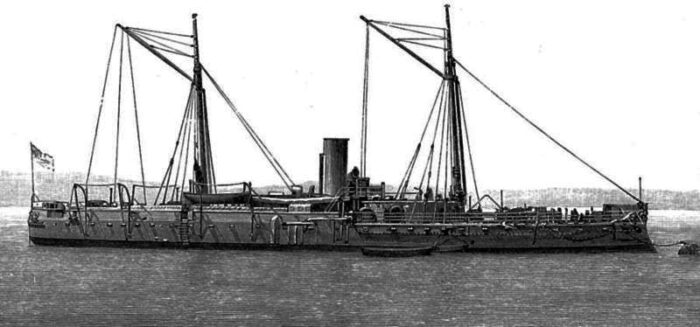
Hostpur was seen generally a few years after delivery already as a failure. It was originally assumed that the bearings upon which a ctandard Coles turret turned would not survive a ramming impact, explaiging her fixed gun house. The single 12-inch (305 mm) had the choice between four firing-ports through which it could be discharged, cicrulating from one position to another on rails, and the missing angles being provided by the ship itself, but none was directly forward. So she could not fire at her ramming target and could only engage these if the ramming attack missed, thus at very close range.
But her greates issue by far was her low speed. She was slower than virtually all of her potential targets and thus her ramming attacks were all guaranteed to miss. After a few demonstration it was clear she had been poorly designed and became the most useless addition to the RN battle fleet.

Hotspur as guard ship, with her torpedo nets deployed after 1875
As reconstructed by Laird & Sons Co. in the 1880s she bnecame a guard ship, with this time a standard revolving turret with two 12-inch guns in it and at least a faster speed thanks to brand new boilers and even additional armour. As such, she remained in service for a few more years, then spent almist a decade and a half inactive, in and out of decommission. She was part of the massive fleet of obsolete ships ordered by Fisher to be scrapped.
Read More/Src
Books
Marine Intelligence”. Newcastle Courant. No. 10284. Newcastle upon Tyne. 2 February 1872.
Ballard, G. A., Admiral (1980). The Black Battlefleet. Annapolis, Maryland: Naval Institute Press.
Oscar Parkes. British Battleships.
Chesneau, Roger & Kolesnik, Eugene M., eds. (1979). Conway’s All the World’s Fighting Ships 1860–1905.
Links
https://www.pdavis.nl/ShowShip.php?id=1581
https://www.rmg.co.uk/collections/objects/rmgc-object-66987
https://www.battleships-cruisers.co.uk/ship.php?ShipID=3489
https://www.battleships-cruisers.co.uk/ship_photo.php?ProdID=114640
https://www.history.navy.mil/our-collections/photography/numerical-list-of-images/nhhc-series/nh-series/NH-71000/NH-71213.html
https://www.history.navy.mil/our-collections/photography/numerical-list-of-images/nhhc-series/nh-series/NH-71000/NH-71212.html
https://www.worldnavalships.com/hms_hotspur.htm
https://www.worldnavalships.com/forums/thread.php?threadid=1330
http://www.dreadnoughtproject.org/tfs/index.php/H.M.S._Hotspur_(1870)
https://en.wikipedia.org/wiki/HMS_Hotspur_(1870)
https://commons.wikimedia.org/wiki/Category:HMS_Hotspur_(ship,_1870)
Model Kits
HMS Hotspur: Armo No. 700-63 1:700



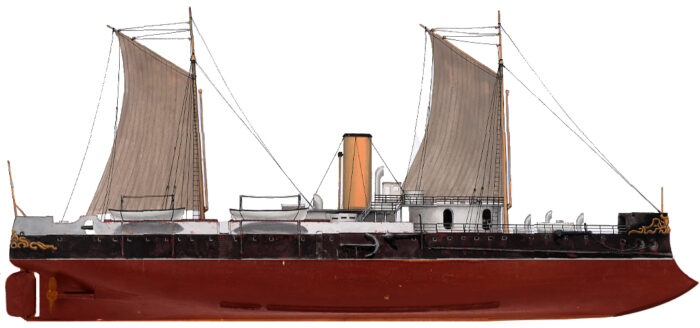

 Latest Facebook Entry -
Latest Facebook Entry -  X(Tweeter) Naval Encyclopedia's deck archive
X(Tweeter) Naval Encyclopedia's deck archive Instagram (@navalencyc)
Instagram (@navalencyc)





 French Navy
French Navy Royal Navy
Royal Navy Russian Navy
Russian Navy Armada Espanola
Armada Espanola Austrian Navy
Austrian Navy K.u.K. Kriegsmarine
K.u.K. Kriegsmarine Dansk Marine
Dansk Marine Nautiko Hellenon
Nautiko Hellenon Koninklije Marine 1870
Koninklije Marine 1870 Marinha do Brasil
Marinha do Brasil Osmanlı Donanması
Osmanlı Donanması Marina Do Peru
Marina Do Peru Marinha do Portugal
Marinha do Portugal Regia Marina 1870
Regia Marina 1870 Nihhon Kaigun 1870
Nihhon Kaigun 1870 Preußische Marine 1870
Preußische Marine 1870 Russkiy Flot 1870
Russkiy Flot 1870 Svenska marinen
Svenska marinen Søværnet
Søværnet Union Navy
Union Navy Confederate Navy
Confederate Navy Armada de Argentina
Armada de Argentina Imperial Chinese Navy
Imperial Chinese Navy Marinha do Portugal
Marinha do Portugal Mexico
Mexico Kaiserliche Marine
Kaiserliche Marine 1898 US Navy
1898 US Navy Sovietskiy Flot
Sovietskiy Flot Royal Canadian Navy
Royal Canadian Navy Royal Australian Navy
Royal Australian Navy RNZN Fleet
RNZN Fleet Chinese Navy 1937
Chinese Navy 1937 Kriegsmarine
Kriegsmarine Chilean Navy
Chilean Navy Danish Navy
Danish Navy Finnish Navy
Finnish Navy Hellenic Navy
Hellenic Navy Polish Navy
Polish Navy Romanian Navy
Romanian Navy Turkish Navy
Turkish Navy Royal Yugoslav Navy
Royal Yugoslav Navy Royal Thai Navy
Royal Thai Navy Minor Navies
Minor Navies Albania
Albania Austria
Austria Belgium
Belgium Columbia
Columbia Costa Rica
Costa Rica Cuba
Cuba Czechoslovakia
Czechoslovakia Dominican Republic
Dominican Republic Haiti
Haiti Hungary
Hungary Honduras
Honduras Estonia
Estonia Iceland
Iceland Eire
Eire Equador
Equador Iran
Iran Iraq
Iraq Latvia
Latvia Liberia
Liberia Lithuania
Lithuania Mandchukuo
Mandchukuo Morocco
Morocco Nicaragua
Nicaragua Persia
Persia San Salvador
San Salvador Sarawak
Sarawak Uruguay
Uruguay Venezuela
Venezuela Zanzibar
Zanzibar Warsaw Pact Navies
Warsaw Pact Navies Bulgaria
Bulgaria Hungary
Hungary

 Bundesmarine
Bundesmarine Dutch Navy
Dutch Navy Hellenic Navy
Hellenic Navy Marina Militare
Marina Militare Yugoslav Navy
Yugoslav Navy Chinese Navy
Chinese Navy Indian Navy
Indian Navy Indonesian Navy
Indonesian Navy JMSDF
JMSDF North Korean Navy
North Korean Navy Pakistani Navy
Pakistani Navy Philippines Navy
Philippines Navy ROKN
ROKN Rep. of Singapore Navy
Rep. of Singapore Navy Taiwanese Navy
Taiwanese Navy IDF Navy
IDF Navy Saudi Navy
Saudi Navy Royal New Zealand Navy
Royal New Zealand Navy Egyptian Navy
Egyptian Navy South African Navy
South African Navy






























 Ukrainian Navy
Ukrainian Navy dbodesign
dbodesign